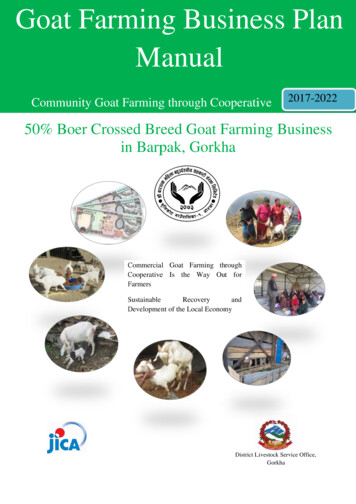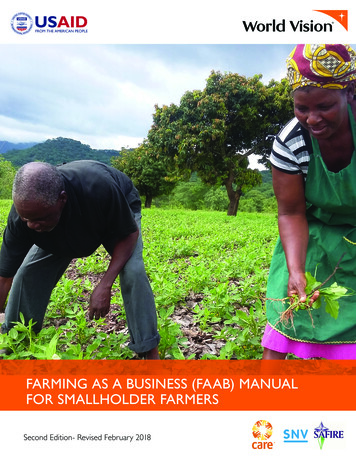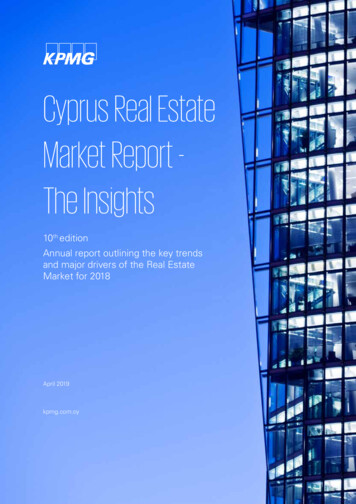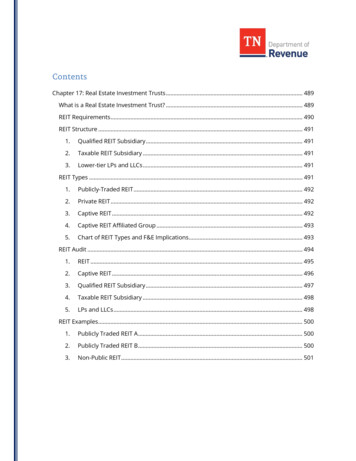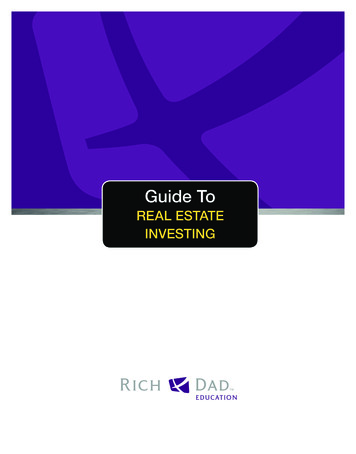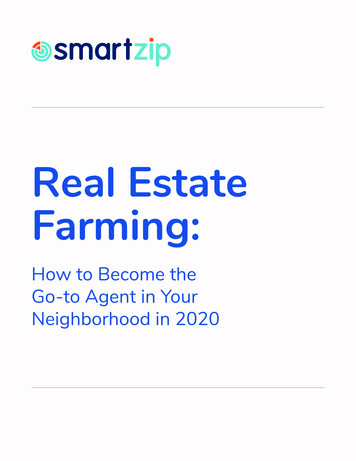
Transcription
Real EstateFarming:How to Become theGo-to Agent in YourNeighborhood in 2020
Real estate farming is the strategy real estate agents use toposition themselves as the go-to resource for a particularneighborhood. To successfully farm a neighborhood, first, youmust learn all you can about the properties and the people livingthere. Then, create a message tailored to those particular peopleand deliver it regularly.In this article we’ll discuss why real estate farming is such an effective lead generationstrategy, the homework you need to do before you can start nurturing these potentialleads, and, of course, pro-tips on the messaging you use to accelerate yourself on thepath to becoming the friendly neighborhood real estate agent.Real Estate Farming: How to Become the Go-to Agent in Your Neighborhood in 2020www.smartzip.com - source: https://theclose.com/real-estate-farming2
Geographic Farming 101:Why Are Real Estate Farms So Effective?Geographic farming is a powerful approach to lead prospecting because it zeros in on your audience and forces you tolaser focus your marketing message. Rather than trying to be all things to all buyers and sellers, a real estate agent whofarms knows more about who they’re targeting messages for.This allows those messages to be more tailored to the needs and desires of your audience, and therefore more effective.When you hear the word “farming,” most of us think of agriculture, of growing things. You can think of your real estatefarm much in the same way:First, you plant the seeds of transactions by identifying homes in a particulararea that would be excellent candidates for sale one day. Then, you nurturethose seeds by establishing a relationship in the neighborhood with the ownersof those homes through regular communication and community involvement.Finally, when it comes time for those owners to sell their home, you’re there toharvest the sales.This long term approach to consistent customized messaging puts you top ofmind or at least in the running for just about every seller in that neighborhood,as well as makes you an easy referral in the event that anybody connected tothose homeowners is looking to buy or sell.How Much Is My Real Estate Farm Going to Cost Me?There’s definitely an upfront cost to effective real estate farming, but the returns on your farm will pay for the investmentmany times over if you can stick with it.Let’s say that for your farm of 250 homes, the turnover rate was right around 5%. This would mean you could expectabout 12 or 13 homes to be sold from that neighborhood every year.Let’s all figure that the absorption rate is about three months, meaning that it is a seller’s market and the demand forproperty in your neighborhood is outstripping the supply.Finally, let’s assume that the median sale price of homes in your neighborhood is 250,000. If your farm is functioningmoderately and you’re capturing just 25% of the sales in the neighborhood, you’re closing four properties a year, or 30,000 in GCI (assuming a 3% commission rate).Also remember that your success will have a snowball effect. Every closed deal will mean another evangelist singingyour praises and connecting you with referral clients. If you do this right, you may end up getting most or even all of yourbusiness from referrals in a few years.Invest 8,282 to make 30,000? Yes please.Real Estate Farming: How to Become the Go-to Agent in Your Neighborhood in 2020www.smartzip.com - source: https://theclose.com/real-estate-farming3
4 Important Things to Consider When Choosinga Real Estate Farm AreaBefore you can begin establishing yourself as the go-to real estate agent in the area, you first have to choose and thenunderstand a neighborhood. The best approach to your first real estate farm is to choose a place close to home, a placethat you already know well. Why? There’s a couple of reasons.1. Start Your Real Estate Farm Somewhere You’ve Got Built-in ExpertiseChoosing to farm for real estate leads close to home is easier because youalready know the ins and outs of the neighborhood, literally and figuratively.The residents of a neighborhood need to trust you as an expert in wherethey live or want to move to, and if you live there too, they know that you canidentify with the experience of calling that area home.A great way to bolster your expertise in an area is to create a hyper-localonline hub for the neighborhood like the ones provided by Parkbench. With aParkbench website, you create a place where members of the neighborhoodcan go to get information about events, local news, neighborhoodhappenings, and of course, real estate, all brought to the members of yourreal estate farm by you.2. Choose a Real Estate Farm Area Where You’ve Got Name RecognitionOne of the challenges of real estate farming is just getting your message inthe door. In a day and age where spam communication appears in our textmessages and email inbox as well as mailboxes, consumers are much morewary of opening unsolicited communication from an unknown source.However, if they already know your name because you’re a neighbor andyou’ve got a local address, you’re more likely to reach more people withyour message.As we mentioned, sticking close to home for your first real estate farm areamakes a lot of sense. But, just being close to home isn’t the only factor youneed to think about before choosing a farm area.3. Your Real Estate Farm Should Have No More Than 500 HomesRemember, the narrower your audience is, the more personalized(and therefore effective) your messaging can be.Having a larger farm and buying in bulk might seem like it makes more senseeconomically, but since your messaging has to be more generic in order tomake sense for a larger audience, your message is less effective. This is whya smaller farm is the way to go.If you’re considering your first real estate farm, 250 homes or less makeseven more sense.Even though the cost per piece of mail will be slightly higher, the loweroverall number of homes keeps your overall costs down and allows yourmessage to be laser-focused, two things you’ll need to keep in mind as youare starting out.Real Estate Farming: How to Become the Go-to Agent in Your Neighborhood in 2020www.smartzip.com - source: https://theclose.com/real-estate-farming4
4. Choose a Real Estate Farm With Homes That SellSpend some time researching on your local MLS and make sure theneighborhood you’re considering for your real estate farm has homes thatare likely to sell based on your local market conditions.Yes, finding recent sales in your farm area at this stage in the game is a goodthing, it means that there’s at least some level of interest in the area you’reconsidering. But, don’t shut down a neighborhood just because it doesn’thave any recent sales. It could be that the area is underserved by the localreal estate community or that the homebuyers aren’t yet aware of this upand coming neighborhood.How exactly do you research your neighborhood so that you get all theknowledge that you need?The 4 Steps to Real Estate Farming ResearchOnce you’ve picked your real estate farm area, then the work of research and understanding everything you can aboutthe neighborhood begins. There are four different categories of research you need to do in order to equip yourself toconnect with the residents of that area.Though this seems like a lot of work, this knowledge will be a vital part of engaging your audience, so set aside sometime and get it done.Geographic ResearchProperty ResearchInventory ResearchDemographic ResearchReal Estate Farming: How to Become the Go-to Agent in Your Neighborhood in 2020www.smartzip.com - source: https://theclose.com/real-estate-farming5
1. Defining Your Farm Area: Geographic ResearchAre there geographic elements of your farm area that are going to affect its salability either as a whole or in part?For instance, are there homes in your neighborhood with private frontage on a body of water? Or maybe there’scommunity beach access for the whole neighborhood? Is there a major highway nearby that you can hear from thebackyard of particular homes? Is there a fantastic new grocery store on a block that everyone is talking about? Forbeshas written about how just living near a Whole Foods can boost your home’s value.Understanding the geographic features in the farm area is certainly going to be able to help you speak with authorityabout the area when buying and selling conversations occur, but this research is also important in that it helps youspeak with authority with the residents of the area who are still learning that they can trust you to be a source ofknowledge and expertise.Make a list of all the geographic features that will affect the sale of property either positively or negatively (or better yet,grab a map and note them right on it), and learn all you can about these items. These are things that the residents ofyour farm live with every day, if you want to be the neighborhood real estate agent, you’ve got to know about them too.2. Defining Your Farm Area: Property ResearchOnce you’ve spent some time learning about the landscape of theneighborhood, it’s time to learn about the properties themselves. In ahigh-density area with a lot of vertical construction, this is an easier tasksince units in a multi-unit building tend to have more similarities than anarea of single-family homes.But, even a neighborhood with all single-family residences can be parsedout easily if you know what to look for. Here are some starting points for thedata to look at when doing this property research; your local MLS is going tobe the go-to for all this data.Real Estate Farming: How to Become the Go-to Agent in Your Neighborhood in 2020www.smartzip.com - source: https://theclose.com/real-estate-farming6
3. Defining Your Farm Area: Inventory ResearchNow that you know more about the neighborhood and the homes in it, let’s turn our attention to the market behaviorof the neighborhood. You can’t very well call yourself a real estate expert for a particular neighborhood if you don’tknow what’s selling, how often, and for how much, but that isn’t where your investigation stops.Inventory can be a tricky metric to try and quantify, which is why if you are going to talk about and try to predict thefuture demand for homes in a particular area, as well as how you think the neighborhood will respond to that demand,you need to know about absorption rate and turnover rate.Absorption RateAbsorption rate helps you predict the number of months’ worth of inventory exist in a particular place, a powerfulstatistic to have at your fingertips when discussing the real estate market.How to calculate the absorption rate for your farm area:[Number of Active Listings Last Month][Number of Listings Sold Last Month] Absorption Rate (Months of Inventory)Between four and six month’s worth of inventory is considered a balanced market, less is considered a seller’s market,more is considered a buyer’s market.So, for example, say your farm area had 20 homes actively for sale last month, and six closings.20 Active Listings Last Month6 Listings Sold Last Month 3.33 (Months of Inventory)If no other properties were to hit the market, your farm area would run out of inventory in 3.33 months, making this aSELLER’S market.If you don’t have much data to work with, find neighborhoods similar to yours that have more listings and sales tocalculate their inventory numbers and use them as an analogue to your own.Turnover RateJust as the absorption rate helps you to understand the external market forces working on your farm area, the turnoverrate helps you understand the internal forces.The turnover rate measures the number of homes in your farm area that sell in a given time compared to the overallnumber of homes. For example, say you’ve got a farm area of 300 homes, and last year 20 of them sold.20 Listings Sold Last Year300 Total Listings 6.6% (Turnover Rate)A high turnover rate is great for real estate agents because it means that there will be more transactions to close.However, a low turnover rate isn’t necessarily a red flag. Low turnover could just mean an underserved market, especiallyif the absorption rate for like neighborhoods is high, and would be a major opportunity for a real estate agent.Generally speaking, a turnover rate of between five and 10% is considered average-performing for a neighborhood.Real Estate Farming: How to Become the Go-to Agent in Your Neighborhood in 2020www.smartzip.com - source: https://theclose.com/real-estate-farming7
Combining the Absorption Rate and Turnover RateUsing your turnover and absorption rate calculations, you can begin to estimate your potential income from aneighborhood farm. Using the example above, if a particular neighborhood has a turnover rate of about 20 homes ayear, and the market shows no sign of slowing demand, then a high functioning farm that grabs 40% of the sales inthat neighborhood would see eight transactions from it.Plug your data about the median sale price into this formula and all of a sudden you have real numbers to be shooting for.4. Defining Your Farm Area: Demographic ResearchLast, but certainly not least, is the demographic research. It is now time to understand better the people who live inthe neighborhood you want to farm.Here are some examples of the demographic data you should be researching: Average age of the person living in your farm areaFamily statusEducationWhat are their preferred methods of communication?How do they consume news and information?Are they on social media?(Please remember, this sort of demographic data is for the purposes of understanding the makeup of your existingfarm area, not for the purposes of populating it. To consider a buyer a candidate for a property based on race, color,religion, gender, handicap, familial status, or national origin is a violation of the Civil Rights Act of 1968.)Though the market is going to tell the tale when it comes to the number of homes that will move in a particularneighborhood every year, understanding your audience will better allow you to craft a message that will resonate withthem, and allow you to capture more of those sales as your own.How to Create Your Real Estate Farm Marketing StrategyNow that you know all the important information about your neighborhood farm, it is time to start planning out yourmessage strategy and actually releasing this communication into the wild. But, before we do that, let’s review the fourmost important things you have to remember when communicating with your farm area.1. Every Message Must Provide ValueFirst and foremost, every message you send must provide some sort of value to the people who are reading it. Itdoesn’t have to be the same value each time (in fact, it should be varied!), but there should be something that yourreceiver walks away from your message better for reading it. The WIIFM (What’s In It For Me?) factor needs to beconsidered with every message you send.2. Every Message Must Have A Call To ActionAlmost as important as value is a call to action. Every message you send to your farm recipients must contain adirective, some push down the funnel, even if that push is incredibly small and discrete. For instance, not everymessage has to end with “Call today to list your home with me.” Something more subtle like, “Sign up to receive aregular market report about your neighborhood” is also a significant funnel mover.Real Estate Farming: How to Become the Go-to Agent in Your Neighborhood in 2020www.smartzip.com - source: https://theclose.com/real-estate-farming8
3. Statistics Are Powerful Tools, But They Get Dry FastNumbers are your allies when it comes to putting together powerful farming messages, but they can get boring veryquickly, so use them properly.Remember, homeowners aren’t just living in a house they bought, they’re living in an INVESTMENT they made.Owners want to hear about how their investment is doing, so tailor your message toward the performance of theirinvestment. However, don’t overload with statistics, keep these messages to once a quarter at the most.4. Your Messaging Must Be ConsistentReal estate farming is a long game. While you may get compliments on your messaging right out of the gate, youshouldn’t expect an immediate turnaround of clients from your farm after week one.In order to harvest from your farm, you have to nurture your leads consistently, which means delivering them regular,quality content for at least a year. Most real estate agents start seeing a positive ROI from their farming efforts afterabout 12 months of work. Using a CRM will allow you to nurture your leads in an organized manner, with 360 viewsof every lead, as well as tracking for your emails, calls, and meetings. As a bonus, Smartzip.com offers email templatesto save you time and keep you in constant contact with your leads.Preplanned Real Estate Farming Postcards — (Monthly)The backbone of your snail mail campaign for real estate farming is the postcard. Though this is a staple that’s been donebefore by countless real estate agents, it’s still a great way to convey information, statistics, and authority to your farm area.Use these postcards to deliver a quarterly snapshot of the market in the neighborhood, to deliver recipes or sportsschedules, whatever is going to provide value to your recipients.Smartzip.com provides a wide range of postcard templates for all sorts of different messages, upload your recipient listsand have Smartzip.com drop them in the mail for you too.On-demand Real Estate Farming Postcards ― Property UpdatesPostcards are a great way to get a quick word out to people in the farm about property. You might be saying, “If quick iswhat we’re going for, why not use the website or the Facebook Group?”Well, two answers to that question: First, you SHOULD use those channels to announce things like New Listings, OpenHouses, Sold Property, or Price Reductions, but this shouldn’t be the ONLY way you do it.Secondly, the life of an electronic message is notoriously short, and you want your recipient to remember what you haveto say, and a postcard is a great way to do that.Send out postcards to at least the 25 or 50 properties closest to a: New Listing Price Reduced Listing Listing with an Open House Sold PropertyWith Smartzip.com you can customize templates so all you have to do is upload a picture, an address, and your recipientlist.Smartzip.com did a deep dive into postcard best practices and featured some the best templates for postcards like these.Real Estate Farming: How to Become the Go-to Agent in Your Neighborhood in 2020www.smartzip.com - source: https://theclose.com/real-estate-farming9
Real Estate Farming Letters (Quarterly)Since you’re hitting your farm with quick messages every month, up that ante once a quarter with a letter instead ofa postcard.With more space for in-depth thoughts and analysis, the real estate letter is a great place to do market deep dives,talk about what’s going on in your business, shout out good works in the community, or any other message you wantto communicate to your farm that shows you are the expert in not just the act of buying and selling homes in theirneighborhood, but also LIVING in this community.Letters are a great way to prospect non-farm areas too. We’ve pulled together 11 real estate prospecting letter templatesas a helpful resource to these prospecting ventures, check it out and start upping your prospecting game too. Farminga high-end neighborhood? Consider handwriting those letters. Yes, it is going to be time-consuming, but the personaltouch provided will pay off in spades with discerning sellers.Real Estate Farming Door Knocking (Annually)As any sales professional will tell you, the best way to move a prospect through the funnel is to shake their hand and lookthem in the eye. Sure, you risk rejection and some awkward moments here and there, but remember, these people havebeen hearing from you, they know who you are, you know who they are.Make a plan to head out into the neighborhood once a year, knock on doors, shake hands, introduce yourself, hand out abusiness card and reassure people that when they are ready to sell, you are the person to help them.Just like your other prospecting message, make sure you are offering them something of value with your visit, as well asa call to action. Offer a free CMA, invite them out to coffee, let them know about your next open house, leave them betterthan before you arrived.Bringing It All TogetherReal Estate Farming is an effective means of developing a consistent source of seller and buyer leads, and the best partabout farming is that your rate of return on your investment improves over time as your messaging gets sharper, as morepeople recognize you, and as your sales stats in the neighborhood improve.Real Estate Farming: How to Become the Go-to Agent in Your Neighborhood in 2020www.smartzip.com - source: https://theclose.com/real-estate-farming10
www.smartzip.cominfo@smartzip.com (855) 661-1064 6200 Stoneridge Mall Rd, Suite 300 Pleasanton, California
Real Estate Farming: How to Become the Go-to Agent in Your Neighborhood in 2020 www.smartzip.com - source: https://theclose.comreal-estate-farming 4 4 Important Things to Consider When Choosing a Real Estate Farm Area Before you can begin establishing yourself as the go-to real estate agen
